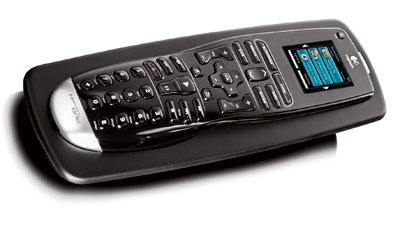Logitech Harmony One Advanced Universal Remote Control Page 2

Performance Some components have a weight and a heft that say, "I'm packed with technology." Pick up an iPhone, and you can just tell that it's crammed with silicon and magic. Surprisingly, the One doesn't give off that vibe. Even the "inferior" Model 670 just feels more solid. This isn't necessarily a shortcoming, just an observation.
The One functions like all other Harmony models. Press an activity button, and the remote fires up your system accordingly. If something gets out of sync, the Help button can sort things out. The IR blaster is good but not exceptional. My cable box is behind perforated-metal doors, and occasionally it wouldn't pick up commands, whereas it doesn't have problems with other remotes. There's no provision for adding RF or Z-Wave control.
What really sets the One apart - especially from the Model 880 it replaces - is its ergonomic styling and layout. The remote is neatly arrayed in five clear zones (from top to bottom): LCD touchscreen, menu commands, directional pad, transport controls, and number pad.
The biggest design improvement is with the buttons. Each one is sized differently and shaped with subtle tactile "clues" for easy operation in the dark. And they've been spaced further from each other, making it easy to work the remote even if you have big paws. The One balances nicely in your hand, and you can easily access all of the hard buttons single-handedly with either your right or left thumb. Also, the button icons glow bright white on black, making them very easy to read in the dark. The glow feature is activated whenever you pick up the remote or press a button.
The One's most significant advance is its 2.25-inch color touchscreen, where commands like aspect and recorded list are located, to save hard-button real estate. This is the company's second model to feature a touchscreen. And while it's limited to displaying three activities or six commands at a time, the "buttons" are larger and easier to touch.
I mostly liked using the touchscreen, but I was prone to pressing the wrong area of the screen, causing the remote to send either the wrong command or none at all. My success rate improved greatly if I used my index finger instead of my thumb - but that required two hands.
Bottom Line My first brush with Harmony was in 2003, when I reviewed one of its initial offerings. My report closed with: "If you're looking for a single great remote that's easy enough for the whole family to use, you should seriously consider this. Overall, it's an amazing product." That's even more true of this remote, which represents the culmination of every improvement that Harmony has developed. The One is now the remote to beat - and own - under $300. Or until we see the Two!
Test Reports RSS Feed More Test Reports Back to Homepage What's New on S&V
- Log in or register to post comments



































































